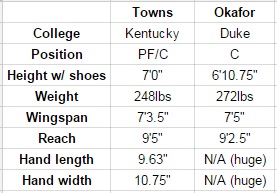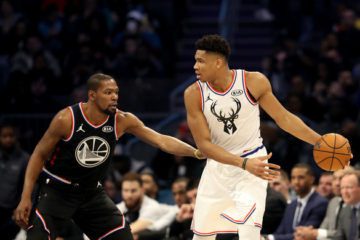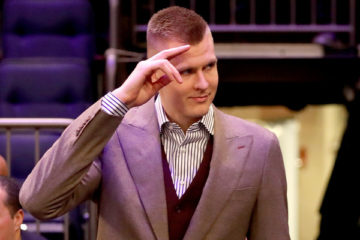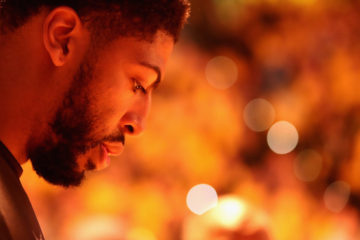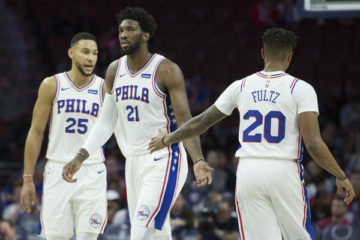2015 Fantasy Basketball: Jahlil Okafor vs. Karl-Anthony Towns
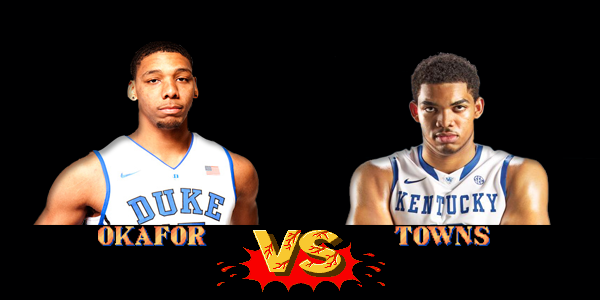
If your favorite team lands the number one or two pick in the 2015 NBA Draft, the consensus says the decision is instantly narrowed down to two names — Jahlil Okafor or Karl-Anthony Towns. Which one should go at the top spot? No better way to figure it out than for it to be settled in a head-to-head fight to the finish Street Fighter style, but in this case we’ll call it “Court Fighter.”
Let’s start with the tale of the tape. Remember all of these measurements were from late-2014 and neither player is participating in the NBA combine, so we likely won’t get renewed measurements for awhile but it’s doubtful much has shifted.
Wow, we’re just getting started and they’re already trading punches back and forth. Towns has the edge in height and reach but Okafor has a lot more weight, longer wingspan, and although it’s not officially documented, he would win in the hands department, too. Just to clarify my hands assumption, basically — sticking to the theme — when Jahlil palms a ball it looks like Zangief squeezing Dhalsim’s head like a tangerine. (Click that link. Do it.) Now that we know how they size up, let’s breakdown their games or style of play pointing out both strengths and weaknesses. Below you’ll see their per-40 minute numbers that gives a better sense of who did what better since it’s hard to judge flat numbers when one guy is on a team 10 deep and only playing 20 minutes a night while the other plays 30.

OFFENSE
Jahlil Okafor:
The paint is the area of expertise for Okafor who in his lone season of college ball was an absolute monster there. With his deadly combination of pure strength (his 277lb frame helps), smooth footwork and limitless repertoire of post moves, Jahlil knew he had an advantage over his defender every night he took to the court. Unlike a lot of big guys who don’t always like to stick to their bread and butter, Okafor never gets tired of dominating down low. Believe this or not, according to Synergy Okafor only took five true “jump shots” through 38 collegiate games playing over 30 minutes a night. He is a true center, and while he won’t be able to bully some NBA centers the way he did at Duke, he still has the size and skill set to have immense upside as a low-post offensive player. I keep mentioning his size and so that you have a better idea how he sizes up in the NBA, he’s right about the same height and weight (Jahlil has him by a few pounds) as DeMarcus Cousins. His shot chart (seen below) is pretty unbelievable but shows — as I said above — how he stuck to his area of dominance.
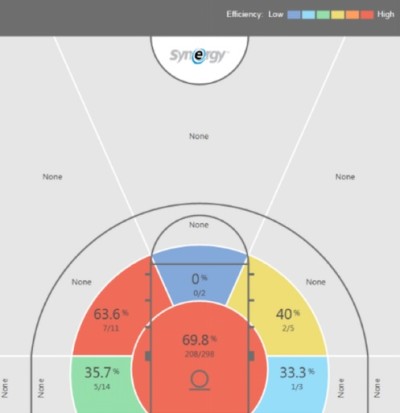
Jah’s large hands contribute to his incredibly soft touch around the rim and he finished 2nd in the NCAA in field goal percentage at .644. He is so strong that he is also a great finisher even through contact, finishing and-1s better than anyone at that level. The big man runs the floor well for a big guy when motivated, and he’s dangerous in transition due to his inside finishing, alley-oop catching ability and above average passing ability for a center. Okafor shows great patience with the ball when a post move is defended well and isn’t afraid to put the ball on the floor, dribble out and take it to his defender while also more than willing to dish out to the open man if another defender helps out. Sure, he needs to develop his jump shot to become more of a threat to knock down a J from the high post and on the baseline, but he’s 19-years-old and he doesn’t have a sloppy jump shot form, he just didn’t have a need to stretch his game there in college instead relying on higher percentage shots.
Then we get to his biggest con on offense and it’s something that fantasy owners will cringe at — free throws. When a players offensive game is so reliant on bruising in the paint, there’s a lot of contact and thus a lot of fouls resulting in trips to the stripe. Jah was 2nd in the ACC in free throw attempts but only converted 99 of his 194 chances (51%). He has plenty of time to improve from the stripe but for his first couple of seasons he may not be a target for fantasy owners who aren’t punting FT%.
Karl-Anthony Towns:
Towns is not near as polished offensively as Okafor, but he’s no slouch. He likes to mix in some jumpers and shoot the rare three-pointer, so while when I watch his game film I see him similar to a young Andrew Bynum. When he takes sporadic long range jumpers he gives me flash backs to Rasheed Wallace. I later saw that some sites have related him to those two names, so I am not alone with that vision. Towns, like Jah, is primarily a paint dweller on offense converting 66% of his shots at the rim at Kentucky. He just isn’t as blessed in the footwork and post-move department (yet) as Jahlil. Towns can get his feet mixed up time to time and relies pretty heavily on jump hooks (uses both his right and left well) and one step drops in the post. When defenders stay in front and contend his post-moves well he still tries to force the jump hook often resulting in bad misses or offensive fouls.
KAT is still very physical down low and his size allows him to get to the rim with ease at times. Towns runs the floor better than Okafor and has the better passing vision of the two from all that I’ve seen. Unlike Jahlil who is a full-on center, Karl — despite being taller — has the attributes to play both power forward and center. He has more of a high/low game than Okafor and is much more likely to pull up a jumper from the T or find the open man across court or slashing to the rim. Okafor tends to catch the ball in or near the paint almost exclusively whereas Towns will catch it above the FT-line or on the side near the arch where he has more room to create from the triple-threat position or off the dribble. His numbers shooting jumpers weren’t anything worth touting but his shot mechanics are superb. It won’t be difficult at all for an NBA coach to have him knocking down Js from the high post and baseline at a high clip. So, while he may need to increase his post move arsenal, the 2nd team All-American still has plenty of offensive weapons. The upside is very high here and you’ll be thrilled to know that he’s also money from the free throw line nailing 109 of his 134 attempts (81%).
Karl’s biggest offensive con is his inconsistency to stay motivated. He has moments where he lacks hustle, doesn’t seem attentive and times where he tries to avoid contact. Hustle can be ingrained in a young player’s mind when they come into the NBA unless you have a JaVale McGee-esque mind then you’re hopeless (but still rich). Then there’s the biggest flaw of his which is when he loses his tough edge. He’ll get the ball in the low-post as he often does and instead of doing a drop step then powering up, he’ll turn in, feel the defender and fades from the contact. It’s something I witnessed numerous times in the game tapes I watched when he should’ve been owning his defender and that all points at a lack of motivation. Maybe the attentiveness is due to playing for a team that went undefeated until the Final Four and often were ahead huge by the second half, but either way it’s not something you like to see out of a top-2 pick.
DEFENSE
Jahlil Okafor:
As it was fairly obvious, Okafor was the better offensive player as of right now although Towns has high upside there as well. Well, the defensive side of the ball is basically the opposite. While Okafor did average 0.8 steals and 1.4 blocks in just over 30 minutes a game, he was far from a defensive stopper for Duke. While very motivated on the offensive end, Jah showed lack of effort on the defensive end way more frequently than you want to see. He’s very slow to get back on defense often leaving his team at a disadvantage leaving the paint vulnerable until he arrives and then scrambling back to find their men after.
Then, odd as it may seem for someone so physical on offense, he isn’t overly physical at all on D. Average big men get good position and leaving him in no mans land. He also looks like a deer in headlights when he’s left defending a man away from the basket. He also was picked on by teams who run the pick-n-roll well by taking advantage of his inability to recover after hedging the ball handler. Basically, when he can’t just rely on his height to do most of the work, he’s simply a poor defender, but he does have the size and quick feet making him very coachable there. He also did a much improved job guarding Wisconsin stud big man Frank Kaminsky in the championship game who plays away from the hoop a lot, so again just shows that he has the physical tools to be a solid defender if he’s got his mind in it.
Now, that all likely sounds like I just dismantled and labeled him an offensive only guy, but the truth is, he can become a competent defender. Duke was a team I thought would be knocked out before the elite 8 due to Okafor not being an opposing threat on defense, but he really stepped it up when it mattered most. As I said above with his height, strength and quick feet he has the tools needed to be a sure bother to opposing big men at the next level. He does keep himself out of foul trouble, unlike…
Karl-Anthony Towns:
Towns is a beast on the defensive end, and he hasn’t even come close to his potential there yet. He’s big, and unlike Jahlil, he’s very physical on the defensive end. Where Okafor’s blocks are more just because of his superior size and positioning, Towns is the type of player that is always hunting his next victim and will come out of nowhere to send your shot the other way. As you saw in the per-40 chart above, he blocks shots at a 4.4 per-40 pace and averaged 2.2 blocks per game in just 20 minutes a night. With this style of overly aggressive play comes KAT’s biggest flaw, his tendency to stay in foul trouble. He fouled out of six games and was one away from it another eight times this season. It’s ok to be aggressive on defense and contact in the paint is a normal thing, but it’s the unnecessary fouls that are worrisome. He falls for head fakes at an alarming rate, just a bit too hungry for his next highlight reel block.
Most of the things Okafor struggles with on defense, Towns is either exceptional at or will at least suffice. He’s great at hedging and recovering against pick-n-rolls, he welcomes being isolated away from the hoop using his length and recovery speed to always stay in the play, and he’s good at standing his ground when being posted up. If Towns can find the discipline to not commit silly fouls, he is a true difference maker on the defensive end from day one in the league. As mentioned in his offensive breakdown, he can play both PF and C and that works on D also. Towns has been blessed with the size, strength and speed to guard any type of big man whether it be a paint bruiser or an away from the rim attacker.
REBOUNDING
As you saw in the per-40 numbers, both players rack up the rebounds nightly with the edge going to Towns. There’s more to this than just their rebounding numbers show because despite Okafor averaging 8.5 boards a night, he’s really not a strong defensive rebounder. His 6.5 defensive rebounds per-40 minutes is actually one of the worst rates of any of the decent or better centers in this draft. Game tape I watched found Okafor once again just relying on his height to grab boards rarely finding a man to box out. He is going to have to work a lot harder on the D-glass at the next level or he’s going to be shamed by opposing centers when his size is no longer anything special. In fact, despite playing over 300 less minutes this past season, Jahlil only grabbed 19 more defensive boards than Towns. Another oddity from this is that Okafor is a plus rebounder on the offensive glass. His 4.6 offensive boards per-40 minutes is 3rd best of centers in this year’s draft, so he just needs to stop being lazy on the defensive end which I would assume his NBA coach would hammer into his head daily. Towns is more well-rounded on the glass sitting 7th and 5th per-40 in defensive and offensive rebounding of the draft class.
CONCLUSION
Despite being a little more raw offensively, Karl-Anthony Towns wins this “Court Fight” showdown two rounds to one and is the guy I would take with the #1 overall pick without question. He doesn’t show near as much laziness nor moments of invisibility on the court which is huge. Sure, he needs to learn not to commit dumb fouls but he’s still a plus-defender and great on the glass on both ends — not to mention he’s far and away better from the free throw line. Both players have nice upsides but Okafor having big issues defensively and a lack of defensive rebounding take him out of the race when compared to a guy like Towns. If Okafor isn’t paired up with a power forward who can help mask his flaws, he could go through a couple seasons of getting totally exposed on the defensive end and feel like a let down early on. I do believe he will improve in his problem areas over time but while he’s doing that Towns has a lot less to work on in those tougher areas to adjust. Once Towns gets his jumper falling, improves his post-move arsenal and learns to avoid bad fouls, he’s going to be a huge get for the team who pulls the top-spot in the draft lottery.
FANTASY
As for fantasy values, both players should be landing in spots that they will get plenty of playing time and will provide pretty good production right away. Towns will likely be the better guy to own with his superior FT% and blocks while Okafor will likely be the better scorer of the two. It’s important to remember though that they are both just 19-years-old and besides a freak like Anthony Davis (13 points, 8 rebounds, 1 assist, 1.2 steals and 1.8 blocks — 36th in 8-category leagues) most players this young fail to produce top-70 numbers or better and neither of these guys is close to what he was coming out of school and that’s not a slight to them at all.
Big thanks to DraftExpress, Synergy and Sports-Reference for their amazing content and coverage that helped me build this piece. Also YouTube allowed me to watch a few games of each player for further personal analysis.
For more fantasy and NBA analysis or to have any questions you may have answered, follow Zack on Twitter @BigZack44


